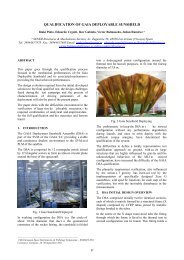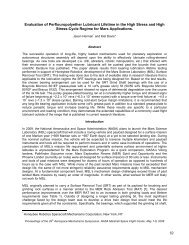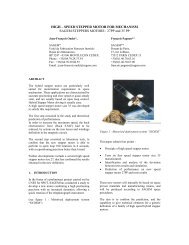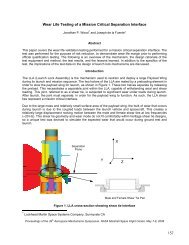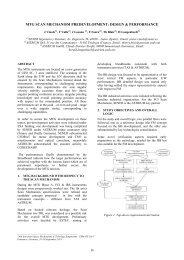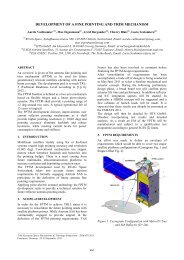Miniaturized Single-Shot Valve and its Application to the ExoMars ...
Miniaturized Single-Shot Valve and its Application to the ExoMars ...
Miniaturized Single-Shot Valve and its Application to the ExoMars ...
Create successful ePaper yourself
Turn your PDF publications into a flip-book with our unique Google optimized e-Paper software.
On some one-time opening valves, <strong>the</strong> sealing element is nei<strong>the</strong>r broken nor pierced, but melted. The<br />
Angström Space Technology Centre has developed a valve made from two silicon discs or wafers<br />
forming a filter <strong>and</strong> a heater [5]. The gas path is obstructed by an indium solder (melting point 156.6°C),<br />
that can withst<strong>and</strong> 100 bar pressure <strong>and</strong> is melted within 10 s requiring power of 13 W. The silicon<br />
element weighs only 0.4 g, but <strong>the</strong> housing weight amounts <strong>to</strong> 140 g. The Jet Propulsion Labora<strong>to</strong>ry has<br />
also built <strong>the</strong> micro-machined isolation valve, opening when a doped silicon membrane melts (less than<br />
30 mJ are needed). The Pyrex housing has a burst pressure of about 200 bar. A disadvantage of <strong>the</strong>se<br />
valves is that parts from <strong>the</strong> solder can be released in<strong>to</strong> <strong>the</strong> carrier gas, although both valve types<br />
integrate a filter that captures <strong>the</strong> larger particles. Ano<strong>the</strong>r <strong>the</strong>rmally actuated valve using paraffin as seal<br />
was developed, but it can be excluded for <strong>the</strong> MOMA instrument because of <strong>the</strong> low actuation<br />
temperature.<br />
Basic Design<br />
Looking at all <strong>the</strong>se valves increased <strong>the</strong> motivation <strong>to</strong> build a new valve. Also, <strong>the</strong> basics of a sealing<br />
valve were retained: it is always a combination of a sealing element <strong>and</strong> of an actua<strong>to</strong>r. The sealing<br />
element can be a frangible pillar, a shaft, a meltable element or a metallic membrane. All possibilities of<br />
sealing element are used in single-shot valves. However not all possible actua<strong>to</strong>rs have been tried for<br />
such an application. Particularly interesting are actua<strong>to</strong>rs that are activated by a temperature change.<br />
Good examples are <strong>the</strong> regulation valve of MOMA, <strong>the</strong> valve with a wax actua<strong>to</strong>r, or <strong>the</strong> valve with a<br />
shape memory alloy. Indeed it only requires a heater, which is a very simple <strong>and</strong> rugged way <strong>to</strong> transmit<br />
energy. Moreover, <strong>the</strong> heater can be placed outside <strong>the</strong> body of <strong>the</strong> valve, which avoids complications<br />
with cables fed trough <strong>the</strong> body of <strong>the</strong> valve. The only problem with <strong>the</strong>rmal actuation is that <strong>the</strong> activation<br />
temperature has <strong>to</strong> be above 130°C, temperature of <strong>the</strong> sterilization process, with a sufficient margin.<br />
Ideally, <strong>the</strong>re should exist an activation temperature point, <strong>and</strong> <strong>the</strong> actuation should not take place<br />
progressively. Which <strong>the</strong>rmal actua<strong>to</strong>r has a well defined actuation temperature? Shape memory alloys<br />
are very interesting, <strong>and</strong> materials that recover <strong>the</strong>ir shape at temperature over 150°C were searched.<br />
The Company Dynalloy could provide high temperature SMA made of NiTiPt with a recovery temperature<br />
of 300°C. But high temperature SMA is still a field of research, <strong>and</strong> <strong>the</strong>se are very costly elements, only<br />
available in <strong>the</strong> form of wires. A rugged design needs an actua<strong>to</strong>r with a longer heritage. A longer<br />
heritage <strong>and</strong> also high working temperature is given by snap-discs. These are made of two layers of<br />
metals foils with different <strong>the</strong>rmal expansion coefficients <strong>and</strong> bend at a determined temperature. This<br />
actua<strong>to</strong>r was favored because it is very easy <strong>to</strong> fit inside a housing, very light, <strong>and</strong> does not produce any<br />
out-gassing, like <strong>the</strong>rmal actua<strong>to</strong>rs based on phase change.<br />
Having chosen <strong>the</strong> actua<strong>to</strong>r, <strong>the</strong> sealing element remained <strong>to</strong> be selected. Also here, <strong>the</strong> criterion was <strong>the</strong><br />
reliability. Therefore it was looked for a component that has a broad use <strong>and</strong> that benef<strong>its</strong> from wide<br />
knowledge. An attractive device on which <strong>the</strong> design could be based on is called burst disc. It is basically<br />
a thin disc of gas-tight material that ruptures at a certain pressure difference between <strong>the</strong> two sections it<br />
separates. These discs are widely used <strong>to</strong> protect against over-pressures. Similar <strong>to</strong> <strong>the</strong> solenoid valve<br />
from Industria, a membrane could be punctured by a pin attached <strong>to</strong> <strong>the</strong> actua<strong>to</strong>r. The first test showed<br />
that <strong>the</strong> force <strong>and</strong> <strong>the</strong> displacement yielded by <strong>the</strong> bimetallic snap-disc were sufficient <strong>to</strong> clearly pierce a<br />
membrane similar <strong>to</strong> a burst disc calibrated at 150 bar. The next step was <strong>to</strong> design <strong>the</strong> body of <strong>the</strong> valve<br />
with heater, tubes, <strong>and</strong> adequate pin attached <strong>to</strong> <strong>the</strong> snap-disc.<br />
Refined Design<br />
In order <strong>to</strong> ensure a high reliability, some important design parameters have <strong>to</strong> be selected carefully. For<br />
example <strong>the</strong> pin has <strong>to</strong> be fixed in a manner that it cannot accidentally <strong>to</strong>uch <strong>the</strong> membrane, <strong>the</strong><br />
membrane <strong>and</strong> <strong>the</strong> housing have <strong>to</strong> be so thick that <strong>the</strong>y withst<strong>and</strong> <strong>the</strong> high pressure.<br />
First of all, a housing made of stainless steel was chosen, <strong>to</strong> be weld-compatible with <strong>the</strong> 1/16'' (1.6 mm)<br />
outer diameter tubes used in gas chroma<strong>to</strong>graphy. As basic shape, a cylinder was chosen, <strong>to</strong> just fit <strong>the</strong><br />
dimension of a commercial snap-disc that is 12.7 mm. From <strong>the</strong> beginning, a configuration was found,<br />
NASA/CP-2010-216272<br />
344



